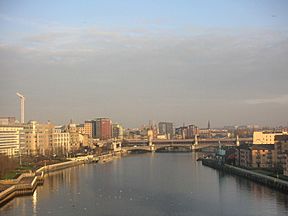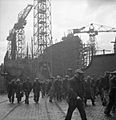River Clyde facts for kids
Quick facts for kids River Clyde (Gaelic: Abhainn Chluaidh) |
|
| River | |
|
The River Clyde at Glasgow's Broomielaw
|
|
| Country | Scotland |
|---|---|
| Counties | South Lanarkshire, Argyll, Ayrshire |
| Cities | Lanark, Glasgow, Bothwell, Greenock |
| Landmarks | Falls of Clyde (waterfalls), Bothwell Castle, Firth of Clyde |
| Source | Lowther Hills in South Lanarkshire |
| - coordinates | 55°24′4″N 3°39′10″W / 55.40111°N 3.65278°W |
| Mouth | Firth of Clyde |
| - coordinates | 55°40′0″N 5°0′0″W / 55.66667°N 5.00000°W |
| Length | 176 km (109 mi) |
| Basin | 4,000 km² (1,544 sq mi) |
The River Clyde is a famous river in Scotland. It flows into the Firth of Clyde, which is an arm of the sea. In Gaelic, it's called Abhainn Chluaidh. In Scots, it's known as Clyde Watter or Watter o Clyde.
The River Clyde is the second-longest river in Scotland. It's also the eighth-longest river in the whole United Kingdom. It flows right through Glasgow, a very big city. Long ago, this river was super important for building ships and for trade across the British Empire. The ancient Romans called it Clota. In the early medieval Cumbric language, it was known as Clud or Clut. It was even central to the old Kingdom of Strathclyde.
Contents
Where Does the River Clyde Start and End?
The River Clyde begins its journey in the Lowther Hills. These hills are located in South Lanarkshire, Scotland. This is where the river's source is found.
The Journey to the Sea
From its source, the river flows for about 176 kilometers (109 miles). It passes through many different areas. Eventually, the River Clyde reaches the Firth of Clyde. This is where the river meets the sea.
The River Clyde's History and Importance
The River Clyde has played a huge role in Scotland's history. It was especially important for industry and trade. Many towns and cities grew up along its banks.
Shipbuilding on the Clyde
For a long time, the Clyde was famous for shipbuilding. Huge ships were built here. These ships sailed all over the world. This industry brought a lot of jobs and wealth to the area. Even today, shipbuilding is still important, though not as big as it once was.
Trade and Transport
The river was also a busy route for trade. Goods were moved up and down the river. This helped Glasgow become a major port city. The river's easy access to the sea made it perfect for trading with other countries.
Landmarks Along the River Clyde
As the River Clyde flows, it passes many interesting places. These include natural wonders and historic buildings.
Falls of Clyde
One famous natural landmark is the Falls of Clyde. These are beautiful waterfalls. They are located near the town of Lanark. The falls are a popular spot for visitors.
Historic Castles and Towns
The river also flows past Bothwell Castle. This is a large medieval castle ruin. It stands proudly on the river's bank. Further downstream, the river reaches cities like Glasgow and Greenock.
Modern River Clyde
Today, the River Clyde is still a vital part of Scotland. It's used for many things, from transport to recreation.
Bridges and Buildings
Many modern bridges cross the Clyde in Glasgow. These include the Tradeston Bridge and the Millennium Bridge. The river banks are also home to new buildings. You can see places like the SEC Armadillo and the SSE Hydro.
River Activities
People enjoy walking and cycling along the river. Boats still travel on its waters. The Glasgow Humane Society even patrols the river. They help keep people safe.
Images for kids
-
The river enters the urban environment here, with Glasgow to its north (background) and South Lanarkshire to its south (foreground).
-
New Lanark Mill Hotel and Waterhouses by River Clyde
-
River Clyde navigable channel and sandbanks, leading to the Tail of the Bank at the Firth of Clyde, seen from Port Glasgow looking over the redeveloped Lithgows shipyard site and Greenock's Great Harbour. The Gare Loch is ahead, Ardmore Point to the right.
-
Modern buildings, including the SEC Armadillo, Finnieston Crane, Crowne Plaza Hotel and the SSE Hydro
-
The estuary opens out past Dumbarton.
-
South-facing view of the Tradeston Bridge
See also
 In Spanish: Río Clyde para niños
In Spanish: Río Clyde para niños




















